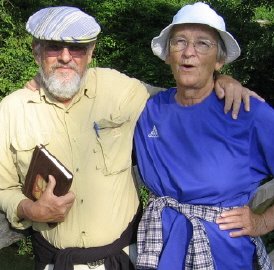Getting from Walla Walla to Irun took us three days and involved going through two of London's airports--something we'd previously sworn we'd never do again. Alas, money talks and we again fell victim to the cheapest flight to London's Heathrow and a two cent flight from Stansted to Bilbao. After taking a bus to Stansted and a night in a suburban B&B, we took a flight on Ryanair to Bilbao. Stansted was a worse nightmare than usual because the computers were down. Although we had arrived the prescribed two hours before flight time, we barely made the flight, and then only with the last-second help of a harried Ryanair expediter. This was followed by an early morning bus--and another day--from Bilbao to Irun. It's jet-lag hell. We did get to spend nearly a full day in Bilbao. (While in Basque Country, I'll be using a random mixture of Basque and Castellano place names.) Here are some random pictures of Bilbao.





And what would a visit to Bilbao be without a visit to the Guggenheim



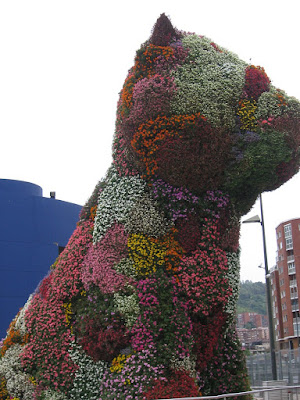

We arrived in Irun early, left our bags at the Albergue and set off to buy some bicycles for the trip. We ended up at the Decathlon store outside Irun where we found some very cheap but serviceable bikes, rode back to the Albergue and spent the day touring Irun. Here are the bikes.

After attending the Pilgrims Mass at the Church of Santa Maria de Juncal, we retired to the Albergue de Peregrinos de Irun for a good night's sleep before heading up to Hondarribia and up the first big mountain of the trip. Here's the Church of Santa Maria.

Day 1, Saturday September 6, Irun to San Sebastian via Hondarribia, Pasaia Donibane, and Pasaia San Pedro--30 kilometers.
Hondarribia is just across a bay from Irun and is a very old walled Basque city. We set out into Basque Country toward the end of the annual "Basque Week," which celebrates a number of elements of Basque Culture, including dancing, much drinking of the rather unique Basque version of Sidra (cider), culminating in the rowing contest in Donostia (San Sebastian). This statue greets you as you enter Hondarribia.

And here are some shots of the Medieval walled city of Hondarribia.





This is the Parador in Hondarribia. Paradors are 4-star hotels througout Spain, most of which are former castles or palaces.
 ...And the gate leading out of the walled city and on up to the Santuario de Guadalupe and Mount Jaizkibel
...And the gate leading out of the walled city and on up to the Santuario de Guadalupe and Mount Jaizkibel
 A little farther on, we reached the 17th Century Santuario de Guadalupe
A little farther on, we reached the 17th Century Santuario de Guadalupe

 The Basques are a seafaring people, so we occasionally saw these model ships in Churches--like this one at the Guadalupe Sanctuary.
The Basques are a seafaring people, so we occasionally saw these model ships in Churches--like this one at the Guadalupe Sanctuary. These two photos are from the top on Mount Jaizkibel,with the Bay of Biscay in the background. A rather dreary day that included a brief downpour.
These two photos are from the top on Mount Jaizkibel,with the Bay of Biscay in the background. A rather dreary day that included a brief downpour.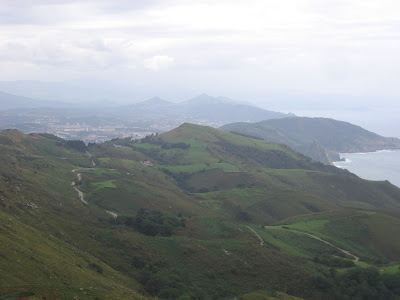
 The ride down off this mountain to the traditional Basque fishing village of Pasaia de San Juan (Donibane in Basque) was quite a thrill and our brakes were put to good use. Here you can either take the 200 meter trip across the bay to Pasaia de San Pedro by boat or take the 5 kilometer ride up river to get there. We chose the former and the boatman happily welcomed our bikes.
The ride down off this mountain to the traditional Basque fishing village of Pasaia de San Juan (Donibane in Basque) was quite a thrill and our brakes were put to good use. Here you can either take the 200 meter trip across the bay to Pasaia de San Pedro by boat or take the 5 kilometer ride up river to get there. We chose the former and the boatman happily welcomed our bikes. Some shots from the boat.
Some shots from the boat.


 We stopped in San Pedro for a "cool one" and there ran into Mariusz from Poland and Gergana from Bulgaria, whom we had first met the day before in Irun. We became very fond of these two, who invariably brightened our day whenever we met on the road.
We stopped in San Pedro for a "cool one" and there ran into Mariusz from Poland and Gergana from Bulgaria, whom we had first met the day before in Irun. We became very fond of these two, who invariably brightened our day whenever we met on the road. The ride from San Pedro to San Sebastian was really nice, and on the way down into the city we came across Arzak, a rather famous Basque restaurant that is universally praised as one of Spain's best restaurants. Some friends at home had encouraged us to try it out, but with food bcourses starting at 75 Euros, we decided a photo of the place was enough.
The ride from San Pedro to San Sebastian was really nice, and on the way down into the city we came across Arzak, a rather famous Basque restaurant that is universally praised as one of Spain's best restaurants. Some friends at home had encouraged us to try it out, but with food bcourses starting at 75 Euros, we decided a photo of the place was enough. San Sebastian is an exceptionally beautiful city that is also very bicycle friendly, with dedicated bike paths that quickly get you to and from many parts of the city, including the beautiful beaches of La Concha. We arrived on a Saturday, and the city was jammed with tourists and there were few economy rooms available. There is no dedicated Pilgrim's Albergue, so after looking around a bit we decided to stay at the youth hostel, which turned out to be a very good choice. Here are some pics of San Sebastian.
San Sebastian is an exceptionally beautiful city that is also very bicycle friendly, with dedicated bike paths that quickly get you to and from many parts of the city, including the beautiful beaches of La Concha. We arrived on a Saturday, and the city was jammed with tourists and there were few economy rooms available. There is no dedicated Pilgrim's Albergue, so after looking around a bit we decided to stay at the youth hostel, which turned out to be a very good choice. Here are some pics of San Sebastian.








 Basque Week was still in full swing, so we decided to stay another day to watch the rowing races and enjoy the street celebrations and the dancing. Basque towns all along the Bay of Biscay send rowing teams to this annual competition, which is held in La Concha Bay. Each team sports a different color costume, so their supporters do the same, and the city is very colorful on race day. After the races, won this year by Castro Urdiales, there is much partying throughout the city, mainly by young people seemingly bent on consuming every last drop beer and sidra available. The side streets in particular are thronged with revelers.
Basque Week was still in full swing, so we decided to stay another day to watch the rowing races and enjoy the street celebrations and the dancing. Basque towns all along the Bay of Biscay send rowing teams to this annual competition, which is held in La Concha Bay. Each team sports a different color costume, so their supporters do the same, and the city is very colorful on race day. After the races, won this year by Castro Urdiales, there is much partying throughout the city, mainly by young people seemingly bent on consuming every last drop beer and sidra available. The side streets in particular are thronged with revelers.


 And not surpisingly, wonderful statues of Don Quixote and Sancho Panza.
And not surpisingly, wonderful statues of Don Quixote and Sancho Panza. The Dancing Competition Finals were also held on this day, and we were part of a very large crowd in the Plaza de Constitution to watch and enjoy it all.
The Dancing Competition Finals were also held on this day, and we were part of a very large crowd in the Plaza de Constitution to watch and enjoy it all.



 Basque Week also brings out a lot of strong nationalist sentiments among the people and there are many hand-painted signs all over "Pais Vasco" demanding independence and charging the Spanish state of various misdeeds, like these two we saw in San Sebastian.
Basque Week also brings out a lot of strong nationalist sentiments among the people and there are many hand-painted signs all over "Pais Vasco" demanding independence and charging the Spanish state of various misdeeds, like these two we saw in San Sebastian.
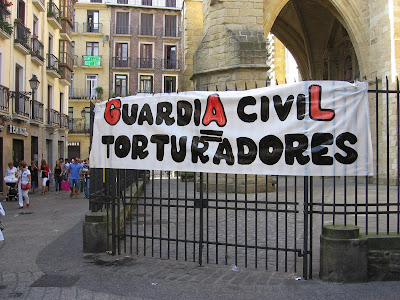 Day 3, Monday September 8, San Sebastian to Zarautz via Igueldo and Orio--25 kilometers. The way from San Sebastian to Zarautz goes directly up the steep hill from the Youth Hostel and soon takes you along some high cliffs overlooking the Bay of Biscay.
Day 3, Monday September 8, San Sebastian to Zarautz via Igueldo and Orio--25 kilometers. The way from San Sebastian to Zarautz goes directly up the steep hill from the Youth Hostel and soon takes you along some high cliffs overlooking the Bay of Biscay.


 A way mark between San Sebastian and Orio
A way mark between San Sebastian and Orio The route climbs fairly steadily until you go down into Orio. Both Orio and Zarautz were still very much in the grip of celebrating Basque Week, and nearly everyone on the street was in traditional costumes. Bands were marching through to and fro and Basque nationalist signs and flags were everywhere.
The route climbs fairly steadily until you go down into Orio. Both Orio and Zarautz were still very much in the grip of celebrating Basque Week, and nearly everyone on the street was in traditional costumes. Bands were marching through to and fro and Basque nationalist signs and flags were everywhere.


 A major pro surfing event was about to take place when we arrived in the little town of Zarautz. For pilgrims, it meant that there was no room in the inn. The town's Albergue was closed for the winter, and the youth hostel was fully booked with surfers from as far away as Hawaii and Australia. We later learned that the event was won by a local boy, Aritz Aranburu. For us, it meant booking a room at an Agriturismo outside of town, which was nice but expensive.
A major pro surfing event was about to take place when we arrived in the little town of Zarautz. For pilgrims, it meant that there was no room in the inn. The town's Albergue was closed for the winter, and the youth hostel was fully booked with surfers from as far away as Hawaii and Australia. We later learned that the event was won by a local boy, Aritz Aranburu. For us, it meant booking a room at an Agriturismo outside of town, which was nice but expensive.Day 4, Tuesday September 9, Zarautz to Deba via Zumaya--30 kilometers.
The route to Zumaya was basically flat and along the sea.

 We passed through Getaria, an interesting little Basque fishing village and the home of Juan Sebastian de El Cano, who took command and completed the circumnavigation of the world after Magellan was murdered in the Philippines.
We passed through Getaria, an interesting little Basque fishing village and the home of Juan Sebastian de El Cano, who took command and completed the circumnavigation of the world after Magellan was murdered in the Philippines.
 The next set of photos record our ride from Getaria on through Zumaya and on into Deba
The next set of photos record our ride from Getaria on through Zumaya and on into Deba



 The tiny 8-bed Albergue in Deba (three bunks high) was very cramped. We again met Mariusz and Gergana. Some pics of Deba
The tiny 8-bed Albergue in Deba (three bunks high) was very cramped. We again met Mariusz and Gergana. Some pics of Deba Deba's Iglesia de Nuestra Senora de la Asuncion
Deba's Iglesia de Nuestra Senora de la Asuncion We have Basque friends in Buenos Aires named Lizaso, so this photo is for them
We have Basque friends in Buenos Aires named Lizaso, so this photo is for them Day 5, Wednesday September 10, Deba to Markina-Xemein via Mutriku and Ondarroa--20 kilometers.
Day 5, Wednesday September 10, Deba to Markina-Xemein via Mutriku and Ondarroa--20 kilometers.The ride as far as Mutriku was filled with more spactular views of the sea, followed by another hill and down into Ondarroa.
 Some pics of Ondarroa
Some pics of Ondarroa


 From Ondarroa, we turned inland to Markina on one of the busiest, most dangerous roads of the entire trip. What a relief to finally arrive in Markina. Here are some old church ruins on the way into Markina
From Ondarroa, we turned inland to Markina on one of the busiest, most dangerous roads of the entire trip. What a relief to finally arrive in Markina. Here are some old church ruins on the way into Markina
 Markina's Ayuntamiento
Markina's Ayuntamiento
 The Spanish have this wonderful practice of gathering in the town's central square or park at the end of the work day, chatting and watching the kids play.
The Spanish have this wonderful practice of gathering in the town's central square or park at the end of the work day, chatting and watching the kids play.
 We stayed at the Cistercian Monastery in Markina.
We stayed at the Cistercian Monastery in Markina.

 Day 6, Thursday September 11, Markina-Xemein to Zenaruzza via Bolibar--10 kilometers.
Day 6, Thursday September 11, Markina-Xemein to Zenaruzza via Bolibar--10 kilometers.The tiny village of Bolibar is the home of the family of Simon Bolivar. Here are the Bolivar Monument and the Church in Bolibar

 We had a nice chat with these two farmers on the way up the mountain to Zenaruzza
We had a nice chat with these two farmers on the way up the mountain to Zenaruzza We had intended to make only a brief visit to the Cistercian Monastery at Zenaruzza, which is two kilometers off the main path, but it began to pour while we were there, so we decided to stay through the storm and ended up staying the night. The Monastery is up one of the steepest hills of our Camino and was well worth the visit. This is the group that arrived about the same time at Zenaruzza
We had intended to make only a brief visit to the Cistercian Monastery at Zenaruzza, which is two kilometers off the main path, but it began to pour while we were there, so we decided to stay through the storm and ended up staying the night. The Monastery is up one of the steepest hills of our Camino and was well worth the visit. This is the group that arrived about the same time at Zenaruzza
There are only 4 monks living there, but their vespers were quite beautiful. The silence after the singing in the vespers was something. Mass the next morning was inspirational. The Cloister at Zenaruzza
 More pictures of the Monastery
More pictures of the Monastery


 The coat of arms of the Monastery, commemorating the eagle that dropped a human skull on the mountain top, thereby selecting the site for the monastery.
The coat of arms of the Monastery, commemorating the eagle that dropped a human skull on the mountain top, thereby selecting the site for the monastery. There were ten of us at the Albergue in the Monastery, and the monks prepared three meals and delivered them to us--a mid-afternoon soup, a late soup and fish dinner, and a hearty breakfast the next morning. Among those staying at the Monastery were Michelle from Seattle, her friend Katya from Germany, and her friend Sergio from Melilla, the Spanish enclave in North Africa. This is also where we first became acquainted with Juan from Venezuela who became a close friend. Leaving Zenaruzza
There were ten of us at the Albergue in the Monastery, and the monks prepared three meals and delivered them to us--a mid-afternoon soup, a late soup and fish dinner, and a hearty breakfast the next morning. Among those staying at the Monastery were Michelle from Seattle, her friend Katya from Germany, and her friend Sergio from Melilla, the Spanish enclave in North Africa. This is also where we first became acquainted with Juan from Venezuela who became a close friend. Leaving Zenaruzza
 And looking back at the Monastery
And looking back at the Monastery Day 7, Friday September 12, Zenaruzza to Gernika--25 Kilometers
Day 7, Friday September 12, Zenaruzza to Gernika--25 KilometersAfter a nice ride down the hill we went on up the steep hill on the way to Gernika, one of the most important Basque cities. And here we said goodbye to our Bulgarian friend Gergana, who will complete her Camino another day. The Albergue was very nice, and here we met Tadeusz, a pilgrim from Poland. He took this photo of us in the Albergue's Comedor.

Here's a replica in tile of the famous Picasso painting of the disaster that befell this historically important Basque town during the Civil War.

Some photos of the Romanesque Cathedral de Santa Maria in Gernika




The Gernika Oak, where leaders from throughout Pais Vasco have met through the centuries. This is not the original, but the trunk of a successor that lived from1742 to 1892. The current living oak dates only from 1986.

Day 8, Saturday September 13, Gernika to Lezama--26 Kilometers.
The route from Gernika to Lezama starts out easily but soon goes steeply uphill to Morga Pass and then sharply downhill to Lezama. There were many beautiful views on the route. The Albergue in Lezama consists of three shipping containers, and nonetheless is quite a nice place to stay. The Hospitalero was very helpful, and we enjoyed our stay there. Here are some pictures taken on the way to Lezama.




 Day 9, Sunday September 14, Lezama to Bilbao--20 kilometers.
Day 9, Sunday September 14, Lezama to Bilbao--20 kilometers.The hill out of Lezama was steep, but there was no traffic at all. Just about as steep going back down into Bilbao. After a brief tour of the Casco Viejo--old town--which we'd missed on our earlier trips to the city, we cycled on down to Basurto and up the hill to the Albergue, which is a very nice and reasonably priced youth hostel. Much like a good hotel with many of the rooms for only two people and cheap laundry facilities. We'd recommend it to anyone looking for reasonably priced accommodations in this beautiful city. We had to bid a fond farewell to our Polish friend Mariusz who was heading home.
On the way down into Bilbao, we came upon our Venezuelan friend Juan
 Here are some random pictures of Bilbao, including the massive sphere sculpture at the Town Hall by Jorge Orteiza
Here are some random pictures of Bilbao, including the massive sphere sculpture at the Town Hall by Jorge Orteiza


 Bilbao's Ayuntamiento
Bilbao's Ayuntamiento
 We came across this pro wrestler and his entourage on our way through Bilbao
We came across this pro wrestler and his entourage on our way through Bilbao Some of scenes on the way out of Bilbao
Some of scenes on the way out of Bilbao This is Bilbao's very unique bridge. Rather than building a bridge that would open for ship traffic, this bridge carries a large container--which holds trucks, cars, and people--from one side of the estuary to the other.
This is Bilbao's very unique bridge. Rather than building a bridge that would open for ship traffic, this bridge carries a large container--which holds trucks, cars, and people--from one side of the estuary to the other. Day 10, Monday September 15, Bilbao to Pobena/Muskiz via Barracaldo, Sestao, and Portugalete--28 kilometrs.
Day 10, Monday September 15, Bilbao to Pobena/Muskiz via Barracaldo, Sestao, and Portugalete--28 kilometrs.The way out of Bilbao was very well marked, and took us through a modern new high-rise neighborhood. The changed a bit as we came into Sestao, where we went through a very large Roma encampment which included perhaps 30 vans and a huge old 6-story building in rather dilapidated condition. (Photo by Tadeusz)
 This is Santiago Matamoros, fairly common in Spanish Churches
This is Santiago Matamoros, fairly common in Spanish Churches
As is this Statue of the Pilgrim Mendicant San Roque, a 14th Century Saint who is always shown with the dog that saved his life by bringing him bread and leading a rescuer to him, and the plague wound on his leg. San Roque is venerated throughout France--his birthplace--Italy, and Spain.
 The Albergue and beach at Pobena
The Albergue and beach at Pobena

Day 11, Tuesday 16 September, Pobena to El Pontarron via Castro Urdiales--30 Kilometers
As usual, the day begins with a huge hill, but the rest of the way was quite nice, as we passed out of Pais Vasco and into the Province of Cantabria. Very little traffic on the N634 because of the new Autovia.
 Yvonne & Sergio from Melilla
Yvonne & Sergio from Melilla Michelle from Seattle & Carlos from Cataluna
Michelle from Seattle & Carlos from Cataluna
The bay, Church, and Castle at Castro Urdiales

 The Bull Ring and Posters at Castro Urdiales
The Bull Ring and Posters at Castro Urdiales

 The crowded Albergue at El Pontarron, and the folks who were there
The crowded Albergue at El Pontarron, and the folks who were there


Day 12, Wednesday September 16, El Pontarron to Colindres via Laredo--20 kilometers.
We are still climbing hills much of the time, but after Laredo, the route is quite nice. Colindres doesn't have much to recommend it. Tadeusz is the only other pilgrim in the Albergue.
Coming down the hill into Laredo
 Laredo street scene
Laredo street scene Ayuntamiento in Laredo
Ayuntamiento in Laredo Laredo Monument to its fishing industry
Laredo Monument to its fishing industry Yvonne & Tadeusz in the Colindres Albergue
Yvonne & Tadeusz in the Colindres Albergue
Day 13, Wednesday September 17, Colindres to Guemes--35 kilometers
This is a relatively flat stage, although it becomes quite hilly after leaving the CA141 at the 12 Century Romanesque Church of Santa Maria de Bareyo. First, this is a photo of the Chapel in a Monastery 0n the way to Santona.
 The forbidding Prison at Dueso
The forbidding Prison at Dueso The 12th Century Iglesia de Santa Maria de Bareyo
The 12th Century Iglesia de Santa Maria de Bareyo This is the Refugio, one of the highlights of the Northern Camino. The Albergue is at the home of the Parish priest, Don Ernesto. It is about a kilometer to two out of Guemes, and should not be missed. You are treated like family. Here are a few photos of our experience there.
This is the Refugio, one of the highlights of the Northern Camino. The Albergue is at the home of the Parish priest, Don Ernesto. It is about a kilometer to two out of Guemes, and should not be missed. You are treated like family. Here are a few photos of our experience there. The next three photos are by Tadeusz--Don Ernesto and dinner at his Albergue
The next three photos are by Tadeusz--Don Ernesto and dinner at his Albergue
 The view from Don Ernesto's Albergue
The view from Don Ernesto's Albergue Day 14, Friday September 19, Guemes to Satander via Ferry from Somo--16
Day 14, Friday September 19, Guemes to Satander via Ferry from Somo--16kilometers
This was a very easy day to the Ferry at Somo, although we almost missed it because there is no sign identifying the point of embarkation. On the way there, we'd met a young Polish lad named Mateusz who came running after us when we gone a half mile past the boarding spot.
 Yvonne and Mateusz in Satander
Yvonne and Mateusz in Satander The Albergue in Satander was very overcrowded, with the bunks about a foot apart. The hospitalera runs a very tight ship. Here's a string of photos taken in the city and environs.
The Albergue in Satander was very overcrowded, with the bunks about a foot apart. The hospitalera runs a very tight ship. Here's a string of photos taken in the city and environs.








 A very nice young couple from Venezuela now living in Barcelona
A very nice young couple from Venezuela now living in Barcelona Day 15, Saturday September 20, Satander to Santillana del Mar--31 kilomers
Day 15, Saturday September 20, Satander to Santillana del Mar--31 kilomersThe first 10 kilometers out of Satander was through an industrial area and on a very busy highway. The rest of the day's trip was a pleasant hilly ride. Santillana is very much a tourist town, but pretty interesting nonetheless. Here we met Irish Liz, the two brothers from Madrid, Hans from Germany, and Juan, a Basque young man from south of San Sebastian.
A stone carver on the way to Santillana
 We went to mass in this beautiful 12th century Romanesque Church
We went to mass in this beautiful 12th century Romanesque Church 


Day 16, Sunday September 21, Santillana del Mar to Cobreces--14.5 kilometers
We found ourselves in the middle of a bike race that involved well over 100 riders. Northern Spain is noted for having more road cyclists than any other part of Spain. The Albergue at the Cistercian Monastery was large and only one other Pilgrim showed up. We decided to stay to attend Vespers. It turned out to be quite a nice experience--the solitude, the prayers, and singing by the 20 Monks were all wonderful.


 Day 16, Monday September 22, Cobreces to San Vicente via Comillas--25 kilometers.
Day 16, Monday September 22, Cobreces to San Vicente via Comillas--25 kilometers.We got to Comillas very quickly, and spent the morning exploring this nice little town. Our friend Juan managed to get himself locked in the grounds of the Gaudi House. We all had a good laugh helping him over the fence. Visited the beautiful old Palace built by don Antonio López y López in 1878 , one of the so-called "Indianos" who made their fortunes in the new world and returned home to lives of luxury in Spain. There are many Indianos houses in this part of Spain. Here are some photos of the Palace and Gaudi's whimsical El Capricho.


 And here's the enormous Jesuit Seminary and University on the opposite hill currently undergoing restoration.
And here's the enormous Jesuit Seminary and University on the opposite hill currently undergoing restoration. The Albergue in San Vicente is in the basement of the Escuela Maritima Pesquera and located on a hilltop very near the Parish Church of Santa Maria de los Angeles. The family that runs the Albergue is very nice and served a delicious dinner and breakfast. There was some communal singing following dinner.
The Albergue in San Vicente is in the basement of the Escuela Maritima Pesquera and located on a hilltop very near the Parish Church of Santa Maria de los Angeles. The family that runs the Albergue is very nice and served a delicious dinner and breakfast. There was some communal singing following dinner.
 The 13th Century Castle of San Vicente
The 13th Century Castle of San Vicente

Day 17, Tuesday September 23, San Vicente to Llanes via Colombrea--38 Kilometers.
A very nice ride this day on the rolling plain between the sea and the Asturian mountains. We passed a number of Indianos houses on the way. We stayed at a Private Albergue next to the Railway station. Juan cooked up a great meal that we all shared...



 Juan and Yvonne
Juan and Yvonne The Soberron Tower in Llanes, now used as the tourist office
The Soberron Tower in Llanes, now used as the tourist office The interesting church in Llanes
The interesting church in Llanes Nice rock formation a little ways out of Llanes
Nice rock formation a little ways out of Llanes
Day 18, Wednesday September 24, Llanes to San Esteban de Leces via Nueva and Ribadasella--37 Kilometers
Another nice day riding along the massive Asturian Mountains. First through the attractive little town of Nueva, which bills itself as the prettiest town in Asturias, and then Ribadasella, where the valley opens up into a broader plain.
 The harbor in Ribadasella
The harbor in Ribadasella Ribadasella had one of the nicest open air markets we saw on the trip
Ribadasella had one of the nicest open air markets we saw on the trip
 The waiter pouring Sidra for us, courtesty of the friendly group at the next table. Note the stream of cider pouring down from his raised hand to a glass in the other. The purpose is to oxygenate the cider, which would otherwise be almost undrinkable.
The waiter pouring Sidra for us, courtesty of the friendly group at the next table. Note the stream of cider pouring down from his raised hand to a glass in the other. The purpose is to oxygenate the cider, which would otherwise be almost undrinkable.
 The last five kilometers from Ribadasella was up a long hill to Leces. The Albergue was in an old school and was quite nice.
The last five kilometers from Ribadasella was up a long hill to Leces. The Albergue was in an old school and was quite nice.Day 19, Thursday September 25, Leces to Sebrayo via Colunga--36 Kilometers
Some big hills but very beautiful.
 This is the Asturian version of the Horreo or grain storage building. They are not as interesting as the Galician version, but they are larger and are often converted into guest quarters or recreation rooms.
This is the Asturian version of the Horreo or grain storage building. They are not as interesting as the Galician version, but they are larger and are often converted into guest quarters or recreation rooms. Here are two photos of the 12th Century Church of San Pedro in the tiny village of Pernus.
Here are two photos of the 12th Century Church of San Pedro in the tiny village of Pernus.

Just another three kilometers farther, we reached the 10th Century Church of San Salvador in Priesca. Here is the church and the lovely lady who gives an informative tour


The Albergue in Sebrayo was crowded but comfortable. The evening was briefly interrupted when a rather peculiar fellow whom none of the pilgrims could understand showed up, grabbed a mattress and dragged it upstairs to the attic where he presumably spent the night without further incident.
Day 20, Friday September 26, Sebrayo to Vega de Sariego via Valdedios--36 kilometers
Leaving Sebrayo, we went to Villaviciosa where we turned south toward Oviedo. The visit to the massive Cistercian Monastery at Valdedios was the highlight of the day. Valdedios is a few kilometers off the main route, but well worth the visit. We arrived in time for mass and a tour of the monastery, inluding the 9th Century Basilica. Here are photos of the original church and the larger monastery.










Sadly, Valdedios was also the site of one of the atrocities of the Spanish Civil War, when in October 1937, some 19 nurses at a temporary psychiatric hospital in the then abandoned monastery were murdered by Nationalist forces and buried in a mass grave.
Day 21, Saturday September 27, Vega de Sariego to Oviedo via Pola de Siero--27 Kilometers
Here's another of those nice Horreos en route to Pola.
 The ride to Pola was almost entirely downhill, a real relief after a difficult uphill day. Ran into one minor problem as my bicycle was attacked by an enormous white dog, which immediately ran away with the owner in pursuit after the attack. The only damage was a badly mangled pannier on the side the critter attacked. We tied it back together and went on down into Pola and on into the beautiful city of Oviedo. Here are some photos of the massive Cathedral in Oviedo.
The ride to Pola was almost entirely downhill, a real relief after a difficult uphill day. Ran into one minor problem as my bicycle was attacked by an enormous white dog, which immediately ran away with the owner in pursuit after the attack. The only damage was a badly mangled pannier on the side the critter attacked. We tied it back together and went on down into Pola and on into the beautiful city of Oviedo. Here are some photos of the massive Cathedral in Oviedo. 

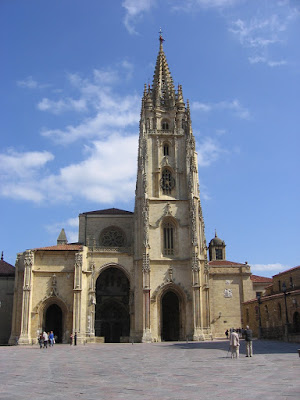

Oviedo's Iglesia de San Isidora

This is the last time we saw Basque Juan, who was working on some Sidra with his friend. We also had to say goodbye to old friends Irish Liz, who had to get back to work in Dublin, and the brothers Juan and Sergio who had to get back to work in Madrid. Our friend Paul the Quebecois also left us this day, as he decided to go over the mountains on the Camino Primitivo. We glimpsed Paul only one more time, in Finisterre--as we were leaving on the bus, Paul was just entering the town on foot.
Here's Juan and his friend at an Oviedo Sidreria

Oviedo is full of interesting sculptures--here's one of a mother and child that we liked. Note how the man on the bench matches the statue!

Day 22, Sunday September 28, Oviedo to Aviles--34 Kilometers.
We had a terrible time finding our way out of Oviedo, although we did enjoy the tour of the city in the process. The ride to Aviles was quite nice, with only one real hill that was very rideable. The entry into Aviles is through Las Vegas, which was about the ugliest town we've ever gone through in Spain. We came across this fellow on the way. In this part of Spain, there are many small farms where much of the work is still done by hand without fancy machinery.
 We liked this church in Aviles--note the ship on the top. Aviles is a significant shipping center that attracts workers from all over. We had conversations with Polish and Russian expats there.
We liked this church in Aviles--note the ship on the top. Aviles is a significant shipping center that attracts workers from all over. We had conversations with Polish and Russian expats there. 
The Albergue in Aviles was billed as "quite nice" but we found it to be badly in need of some upkeep.
Day 23, Monday September 29, Aviles to Soto de Luina--38 Kilometers
After a miserable hill out of Aviles, we arrived at the city of Salinas, where we decided to just take the N632. It worked out OK, with some adventures, including the crossing of two massive bridges. On the second bridge, which was under construction that left us with only one very narrow and rough lane, Yvonne was trailed closely by a convoy of huge trucks with unhappy drivers. Here's Yvonne moments after the crossing.
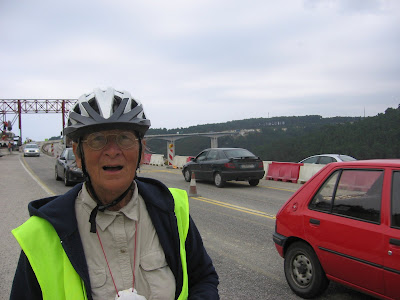
On the way to Soto de Luina, we met and rode with another cyclist, Michael, a German Policeman, who was a much faster rider but who kindly stayed at our pace. Here are Michael and the Albergue in Soto, another very nice former school house.


Day 24, Tuesday September 30, Soto de Luina to Cadavedo--24 Kilometers.
This was a very nice day of biking on quiet roads (mostly the old 632). Hilly but easily rideable. We bid Michael goodbye as he wanted to go on further past Cadvedo. We did have a nice lunch of Sopa de Marisco with Michael. Here some pics.




And here we are after our nice soup lunch.

The Albergue in Cadavedo was small but clean. Cold showers all around!
Day 25, Wednesday October 1, Cadavedo to Pinera--35 Kilometers.
Quiet roads for the first half of the day's ride, then very busy. The Albergue was again in an old school that was quite roomy and nice.
Day 26, Thursday October 2, Pinera to Tapia de Casariego--29 Kilometers.
This was a dark and gloomy day. After a couple long hills, the road was over rollers, and eventually down in the nice little town of Luarca. We wanted to go on to Tol, but couldn't find the way, so we went on to Tapia, a seaside tourist town. There are few waymarks on this section. Yvonne is feeling unwell, so we decided to stay the night in a hotel. Here are some photos taken from behind the Albergue and near the hotel.




Day 27, Friday 3 October, Tapia de Casariego to Ribadeo--12 Kilometers.
An extremely easy day that began in heavy rain but turned sunny as the day wore on. Unlike many of the small beach communities on the route, Ribadeo is a real city. We entered Galicia this day. Crossed the brand new bridge over the Rio Eo into the city. The Albergue is right on the estuary. We had a nice long day touring the city, including a visit with a Danish lady who is a cook on a ship that was on its way to Poland.





Day 28, Saturday 4 October, Ribadeo to Lourenza--39 Kilometers.
We started the day on the trail but lost the arrows and ended up taking the long way over a big mountain to to the 634. We arrived in Lourenza in the middle of the Faba Festival. We had a dinner of Fabas and Pulpo at the Vilalba tent and came under the wing of a local entrepreneur who insisted on feeding us drinks as the Vilalba band played. The serving hours were basically over, so we ate with the staff, danced with the staff, and drank with the staff. Lots of fun!
Here are some pics of the route to Lourenza




 Two very generous entrepreneurs in Lourenza
Two very generous entrepreneurs in Lourenza


 The cooks and waiters get to eat
The cooks and waiters get to eat
 Church of the Monastery of San Salvador in Lourenza
Church of the Monastery of San Salvador in Lourenza

 The Pilgrim Albergue in Lourenza
The Pilgrim Albergue in Lourenza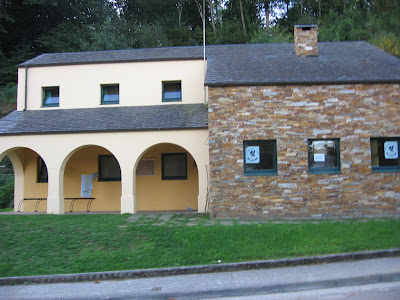 Alex from Adelaide, Australia (a special photo for our grandaughter Adelaide)
Alex from Adelaide, Australia (a special photo for our grandaughter Adelaide) San Salvador at night
San Salvador at night
Day 29, Sunday 5 October, Lourenza to Gontan via Mondonedo--25 Kilometers
A very hard day, with two massive uphill climbs, with a cold headwind most of the day. The Albergue in Gontan, a key center for cattle sales, was very nice. The hospitalera enforced the rule that cyclists couldn't enter the Albergue until after 7 PM, leaving us to wait in the cold for several hours. Our old friend Tadeusz brought us some hot tea, to ease the cold and warm our hearts. As it turned out, the hot shower was more appreciated and well worth the wait.
Looking back at Lourenza

We spent some time in the nice old mountain town of Mondonedo, with its 13th Century Cathedral.


And here's the Cathedral's Statue of the Virgin Inglesa rescued from St Paul's in London during the Protestant Reformation and brought to Mondonedo in 1555.
 Some detail on the Cathedral's exterior
Some detail on the Cathedral's exterior Looking back at Mondonedo
Looking back at Mondonedo An interested old stone engraving (dated January 1903) paying tribute to a local bishop
An interested old stone engraving (dated January 1903) paying tribute to a local bishop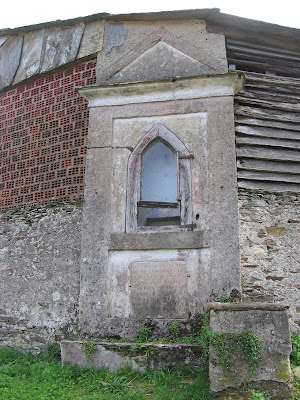 Looking down from the trail into the valley of the Rio Valinadares
Looking down from the trail into the valley of the Rio Valinadares
 An Iron Cross at the Church of San Vicente at the head of the valley
An Iron Cross at the Church of San Vicente at the head of the valley
Day 30, Monday October 6, Gontan to Vilalba--21 Kilometers.
A very nice day. Shortly past Abadin, there is a nice path that parallels the highway. At Martines we picked up the main walkers' route. Had a second flat on Yvonne's bike just a few kilometers from the Albergue in Vilalba. The Albergue was very modern except for the fact that the men's shower had no hot water. A cool gray day.
Here are photos of taken on the way to Vilalba. First the 12th Century Iglesia Santa Maria




The 15 Century Torre das Andrade in Vilalba

Day 31, Tuesday 7 October, Vilalba to Baamonde--18 Kilometers.
A very nice ride with some long hills that were not too steep and very manageable. The Albergue is quite nice--clean and roomy. We had a good menu de dia at Restaurante Galicia. We also spent some time at the museum of Victor Corral Castro, whose work we like a lot. First, some photos of the Church in Baamonde and our dinner group at the Restaurante Galicia





Here's Senor Corral Castro and just a few of his works at the museum he built with his own hands.













Day 32, Wednesday 8 October, Baamonde to Miraz--21 Kilometers
We had a nice path to ride on the entire way. The Albergue in Miraz is run the English Confraternity of Saint James and is in the abandoned former home of the Parish priest. A very interesting place and the hospitaleros were especially helpful. Here are some of the sights along the way.





Day 33, Thursday 9 October, Miraz to Sobrades--27 Kilometers.
We rode the trail the entire way. It was difficult at first--over a rocky moor--but no cars to contend with. The Albergue is in the massive Cistercian Monastery and is really quite excellent.





Day 34, Friday 10 October, Sobrades to O'Pino, 42 Kilometers.
We took a wrong turn at Brea because someone had painted some yellow arrows directing us the wrong way, adding some kilometers. This is the day we joined the Camino Frances, and the flood of people on the trail. We decided to treat ourselves to a hotel in O'Pino rather than fight the mob in the two Albergues that were a couple kilometers on each side of O'Pino.

Day 35, Saturday 11 October, O'Pino to Monte do Gozo--17 Kilometers.
You can really feel Santiago on this penultimate stage. The Alberge in Monte do Gozo is really quite nice, and we strongly urge pilgrims to not believe the bad things most guides say about the place. It is very clean, welcoming, and convenient for the next day's walk on into Santiago. The kitchen facilities are very nice. We met Johannes, a nice young man from Hong Kong who had finished the camino and was hanging around till his flight out came due. Meanwhile, he was getting as many free meals as he could at the Parador in Santiago.




Here's a picture of the lovely French couple we frequently met on the Camino, Jean-Louis and Francoise Rousseau. We remember them fondly.

Day 36, Sunday 12 October, Monte do Gozo to Santiago de Compostela.
We sold the bikes to the hospitalero in Monte do Gozo and hiked on into Santiago in time for mass and all the excitement at the Cathedral. We had a few days to kill before our flight home, so we took a bus to Finisterre. Here are the final photos we took on this Camino.
A very happy group of Portuguese Pilgrims celebrating in front of the Cathedral.




These next four are taken at Finisterre




Our free Pilgrim's meal at the Parador, the Hotel de Reyes Catolicos in Santiago

Entrance to the Parador

